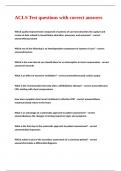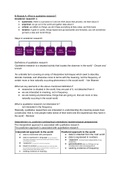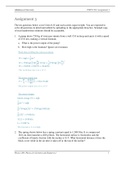Tirza van der Vliet
September 2021
Contents
1 Week 1: Concepts of Game Theory, Static Games with Perfect
information 3
1.1 A Strategic Game . . . . . . . . . . . . . . . . . . . . . . . . . . 3
1.1.1 The Equilibrium Concept . . . . . . . . . . . . . . . . . . 5
1.2 A more General Game Analysis . . . . . . . . . . . . . . . . . . . 6
1.2.1 The Best Response Function . . . . . . . . . . . . . . . . 6
1.3 Dominated Actions . . . . . . . . . . . . . . . . . . . . . . . . . . 7
1.3.1 Dominant Strategy Equilibrium . . . . . . . . . . . . . . . 7
1.4 Bertrand’s Model of Oligopoly Competition . . . . . . . . . . . . 8
1.4.1 Calculation Best Response Function . . . . . . . . . . . . 9
1.5 Electoral Competition . . . . . . . . . . . . . . . . . . . . . . . . 12
1.5.1 Calculation Electoral Competition . . . . . . . . . . . . . 12
2 Week 2: Static Games of Compete Information 2 13
2.1 Mixed Strategy and Mixed Strategy Nash Equilibrium . . . . . . 14
2.1.1 Back to Matching Pennies . . . . . . . . . . . . . . . . . . 15
2.2 Proposition . . . . . . . . . . . . . . . . . . . . . . . . . . . . . . 17
2.3 Dominated Actions in Strategic Games with vNM Preferences . . 18
2.4 Dominant Strategy Equilibrium . . . . . . . . . . . . . . . . . . . 19
2.5 Application of Nash Equilibrium in Mixed Strategies . . . . . . . 20
2.6 Is there a Symmetric Nash Equilibrium? . . . . . . . . . . . . . . 21
3 Week 3: Dynamic Games of Perfect Information 22
3.1 Example of Sequential Game . . . . . . . . . . . . . . . . . . . . 22
3.2 Extensive Game with Perfect Information . . . . . . . . . . . . . 24
3.3 Strategies . . . . . . . . . . . . . . . . . . . . . . . . . . . . . . . 25
3.3.1 Strategies applied to example . . . . . . . . . . . . . . . . 25
3.4 Sequential Rationality . . . . . . . . . . . . . . . . . . . . . . . . 27
3.4.1 Subgame . . . . . . . . . . . . . . . . . . . . . . . . . . . 28
3.4.2 Subgame-Perfect Nash Equilibrium . . . . . . . . . . . . . 28
3.5 Subgame-Perfect Nash Equilibrium: Illustrations . . . . . . . . . 30
3.6 Modified Battle of Sexes . . . . . . . . . . . . . . . . . . . . . . . 32
3.7 Forward induction . . . . . . . . . . . . . . . . . . . . . . . . . . 33
1
,4 Week 4: Static Games of Incomplete Information 34
4.1 Information in Games . . . . . . . . . . . . . . . . . . . . . . . . 34
4.1.1 Example I: A Variant of Battle of Sexes with One-Sided
Incomplete Information . . . . . . . . . . . . . . . . . . . 34
4.2 Bayesian Games . . . . . . . . . . . . . . . . . . . . . . . . . . . 37
4.3 Different Approach to Bayesian Nash Equilibrium . . . . . . . . 38
4.4 Four Classes of Games - Four Equilibria . . . . . . . . . . . . . . 38
4.5 Harsanyi Transformation . . . . . . . . . . . . . . . . . . . . . . . 39
4.6 The Expected Payoff . . . . . . . . . . . . . . . . . . . . . . . . . 39
4.6.1 Nash Equilibrium of Bayesian Game . . . . . . . . . . . . 40
4.7 The Prisoner’s Dilemma with Two-Sided Incomplete Information 40
5 Week 6: Repeated Games 43
5.1 Remember: The Prisoner’s Dilemma . . . . . . . . . . . . . . . . 43
5.2 Repeated Games: Finite vs. Infinite . . . . . . . . . . . . . . . . 44
5.2.1 Finitely Repeated Games . . . . . . . . . . . . . . . . . . 44
5.2.2 Subgame-Perfect Nash Equilibrium in a Finitely Repeated
Game . . . . . . . . . . . . . . . . . . . . . . . . . . . . . 46
5.2.3 Infinitely and Indefinitely Repeated Games . . . . . . . . 46
5.2.4 How does Discounting Work . . . . . . . . . . . . . . . . . 46
5.3 Strategies in Infinitely Repeated Games . . . . . . . . . . . . . . 47
5.4 An Example With Two Players . . . . . . . . . . . . . . . . . . . 48
5.4.1 Interpretation . . . . . . . . . . . . . . . . . . . . . . . . . 49
5.5 Comparative Static Properties . . . . . . . . . . . . . . . . . . . 50
5.6 Considering Another Strategy . . . . . . . . . . . . . . . . . . . . 51
5.7 The Folk-Theorem . . . . . . . . . . . . . . . . . . . . . . . . . . 51
5.7.1 Equilibria in Infinitely Repeated Games . . . . . . . . . . 52
5.8 Axelrod’s Iterated Prisoner’s Dilemma (IPD) Tournaments . . . 52
6 Week 7: Dynamic Games of Incomplete Information 53
6.1 Dynamic Games of Imperfect Information . . . . . . . . . . . . . 53
6.1.1 Definition: Information Sets . . . . . . . . . . . . . . . . . 54
6.1.2 Definition: Strategy of Dynamic Games of Imperfect In-
formation . . . . . . . . . . . . . . . . . . . . . . . . . . . 54
6.2 Example I: A Variant of Battle of Sexes with One-Sided Incom-
plete Information . . . . . . . . . . . . . . . . . . . . . . . . . . . 55
6.3 Information Categories . . . . . . . . . . . . . . . . . . . . . . . . 56
6.4 Example II: An Entry Game . . . . . . . . . . . . . . . . . . . . 56
6.5 Perfect Bayesian Nash Equilibrium . . . . . . . . . . . . . . . . . 57
6.5.1 Are the Nash Equilibria also Perfect Bayesian Equilibria? 58
2
,1 Week 1: Concepts of Game Theory, Static
Games with Perfect information
Game theory is about decision making. Game theory is relevant when the
choices of one player not only affect his own choice and utility, but also the
choices and the utilities of the other players as well. Game theory developed
from being a mathematics a tool to analyze economic situations to its own field
of economics.
1.1 A Strategic Game
A strategic form game or normal form game is a situation where players decide
simultaneously on what to do. These players decide only once. There is no
repeated interaction and their decisions are made at the same time so there is
no knowledge of what the other player is choosing. These type of situations are
modelled in a strategic form game setting.
There is a set of players n, usually there are ≥ 2 players. If there is only
one player, it cannot be a strategic form game, then it is an individual decision
making process.
For each player, there is a set of actions. Ai (denotes the set of actions for
player i ) = [ai , a0i , a00i ] (the different actions i could choose).
For each player there are preferences over the set of action profiles. Whichever
action players prefer. These are denoted by utilities.
There are multiple assumptions for the a normal form game. We continue
to assume that:
1. Players are ”rational”: a rational player is one who chooses his actions to
maximize his payoff consistent with his beliefs about what is going on in
the game. This is a simplifying assumption.
2. Common knowledge: the fact that players are rational and intelligent is
common knowledge among the players of the game.
3. Self-enforcement: any prediction (or equilibrium) of a solution concept
must be self-enforcing.
4. Players are ”intelligent”: an intelligent player knows everything about the
game: the action, the outcomes, and the (distribution of) preferences of
all the players. Players therefore also know the preferences of the other
players.
Simultaneous decisions are represented in the strategic or formal form game.
It is often denoted in a payoff matrix. An example of such a payoff matrix:
3
,The first basic and famous normal form game discussed is the prisoners dilemma.
In this game it is essential that there are only two players, that there are two
actions, and that the preferences of the players are the same.
This is an example of a prisoners dilemma. player one and player two (both pris-
oners) can both choose cooperate or defect. Preferences: Ui (D, C) > Ui (C, C) >
Ui (D, D) > Ui (C, D) or in other words 4 > 3 > 1 > 0. The preference can be
written as Ui if it is a symmetric game because then the preferences for both
players are the same.
The ranking of these characteristics is important for a prisoners dilemma.
In the prisoners dilemma there is a problem of cooperation. They end up in a
strategy in which they both could improve.
The second basic normal form game discussed is the battle of the sexes.
There are again two players (a boyfriend and girlfriend), with the same actions,
however, the preferences differ and the players need to coordinate their actions.
Two players can choose to go to a concert of Bach, or a concert of Stravinsky.
However, both prefer a different one. Preferences:
4
, U1 (B, B) > U1 (S, S) > U1 (B, S) = U1 (S, B)
U2 (S, S) > U2 (B, B) > U2 (B, S) = U2 (S, B)
Basically the first player prefers both going to Bach over both going to
Stravinsky. However, it prefers going to Stravinsky over both going to different
concerts. The second player prefers going to Stravinsky over going to Bach.
However, it also prefers going to Bach over both going to different concerts.
In the battle of sexes there is a problem of coordination.
The third basic and famous normal form game is the stag hunt. There are
again two players (hunters), with the same actions, stag and hare.
This is an example of a stag hunt. Preferences: Ui (S, S) > Ui (H, S) = Ui (H, H) >
Ui (S, H).
If both hunters are working together, they can catch a stag. If they work
individually they can definitely catch a hare, but not a stag. If one puts in the
effort to catch a stag and the other does not, the one who does not put in the
effort is going to catch a hare. The one putting in the effort is going to catch
nothing.
In the stag hunt game there is also problem of coordination.
1.1.1 The Equilibrium Concept
The equilibrium concept we are going to use the most is the Nash equilibrium.
The Nash equilibrium is when no player can do better given that other player
adhere to their actions. If one player does not have an incentive to deviate from
that strategy profile, it is called a Nash equilibrium.
The formal definition of a Nash equilibrium is that an action a* in a strategic
game (with ordinal preferences) is a Nash equilibrium if, for every player i
and every action ai of player i, a* is at least as good, according to player i’s
preferences, as the action profile (ai , a ∗− i ) for every player i.
Ui (a∗) ≥ Ui (ai , a ∗− i ) for every action ai of player i, where Ui is a payoff
function that represents players i ’s preferences.
Looking for the Nash equilibrium in the previous prisoner dilemma, battle
of sexes and stag hunt, we find multiple Nash equilibria.
5
, 1. In the prisoners dilemma, D-D is a Nash equilibrium. Both players have no
incentive to deviate to cooperation, when the other keeps choosing defect.
2. In the battle of the sexes B-B and S-S are Nash equilibria. No player has
an incentive to deviate from their current strategy. For player 1: if player
2 keeps strategy B, then deviating to S lowers their utility. For player 2:
if player 1 keeps strategy B, then deviating to S lowers their utility. This
also happens when looking at the outcome of S-S.
3. In the stag hunt, S-S an H-H are Nash equilibria. Again, no player has an
incentive to deviate from their current strategy.
Nash equilibrium in other words happens when no player has an incentive to
deviate, given the other players play their equilibrium strategy.
1.2 A more General Game Analysis
It can also be the case that there are way more than two players playing the
game or way more than two action sets. Then, we need a more systematic way
to analyze a game. For that, we use the best response function.
1.2.1 The Best Response Function
The best response function is given the action of the other player, what is the
best response to that action? What is the action that gives the highest utility?
The highest utility is always the most preferred (as the player is rational).
The formal definition of the best response function is Bi (a−i ) = [ai ∈ Ai :
Ui (ai , a−i ) ≥ Ui (a0i , a−i ) for every action a0i ∈ Ai . Any action in Bi (a−i ) is
at least as good for player i as every other action of player i when the other
players’ actions are given by a− i. In other words, the best response function
of the i’th player to all the others playing a−i . The best response would be an
action of the i’th player such that this results in the highest utility.
The action profile a* is a Nash equilibrium of a strategic game with ordinal
preferences if and only if every player’s action is a best response to the other
player’s actions: a∗i is in Bi (a−i ) for every player i.
6











